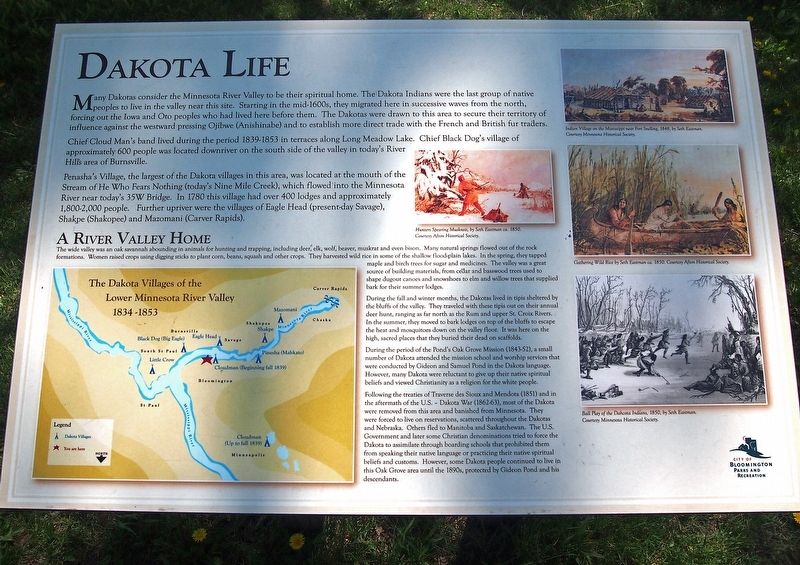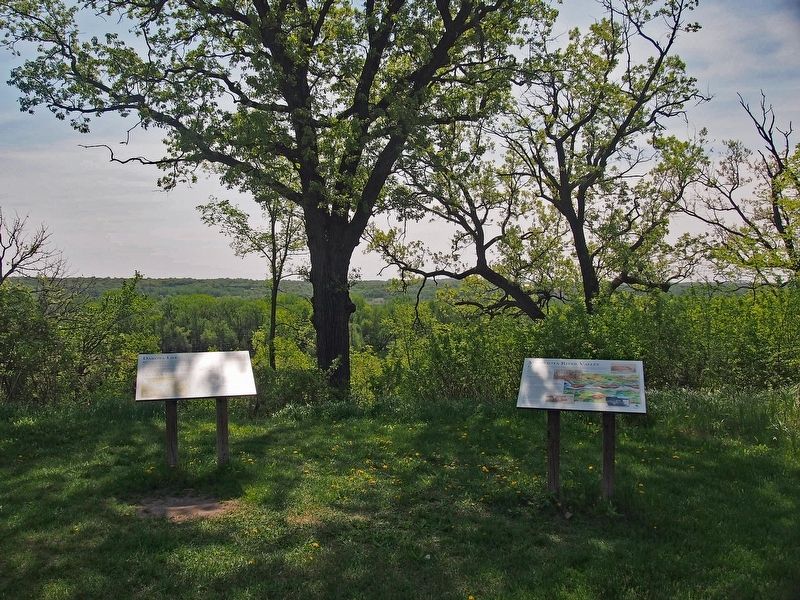East Bloomington in Hennepin County, Minnesota — The American Midwest (Upper Plains)
Dakota Life
Chief Cloud Man's band lived during the period 1839-1853 in terraces along Long Meadow Lake. Chief Black Dog's village of approximately 600 people was located downriver on the south side of the valley in today's River Hills area of Burnsville. Penasha's Village, the largest of the Dakota villages in this area, was located at the mouth of the Stream of He Who Fears Nothing (today's Nine Mile Creek), which flowed into the Minnesota River near today's 35W Bridge. In 1780 this village had over 400 lodges and approximately 1,800-2,000 people. Further upriver were the villages of Eagle Head (present-day Savage), Shakpe (Shakopee) and Mazomani (Carver Rapids).
A River Valley Home
The wide valley was an oak savannah abounding in animals for hunting and trapping, including deer, elk, wolf, beaver, muskrat and even bison. Many natural springs flowed out of the rock formations. Women raised crops using digging sticks to plant corn, beans, squash and other crops. They harvested wild rice in some of the shallow flood-plain lakes. In the spring, they tapped maple and birch trees for sugar and medicines. The valley was a great source of building materials, from cedar and basswood trees used to shape dugout canoes and snowshoes to elm and willow trees that supplied bark for their summer lodges.
During the fall and winter months, the Dakotas lived in tipis sheltered by the bluffs of the valley. They traveled with these tipis out on their annual deer hunt, ranging as far north as the Rum and upper St. Croix Rivers. In the summer, they moved to bark lodges on top of the bluffs to escape the heat and mosquitoes down on the valley floor. It was here on the high, sacred places that they buried their dead on scaffolds.
During the period of the Pond's Oak Grove Mission (1843-52), a small number of Dakota attended the mission school and worship services that were conducted by Gideon and Samuel Pond in the Dakota language. However, many Dakotas were reluctant to give up their native spiritual beliefs and viewed Christianity as a religion for the white people.
Following the treaties of Traverse des Sioux and Mendota (1851) and in the aftermath of the U.S.
- Dakota War (1862-63), most of the Dakota were removed from this area and banished from Minnesota. They were forced to live on reservations, scattered throughout the Dakotas and Nebraska. Others fled to Manitoba and Saskatchewan. The U.S. Government and later some Christian denominations tried to force the Dakota to assimilate through boarding schools that prohibited them from speaking their native language or practicing their native spiritual beliefs and customs. However, some Dakota people continued to live in this Oak Grove area until the 1890s, protected by Gideon Pond and his descendants.
Erected by City of Bloomington Parks and Recreation.
Topics. This historical marker is listed in these topic lists: Native Americans • Wars, US Indian.
Location. 44° 48.718′ N, 93° 16.293′ W. Marker is in Bloomington, Minnesota, in Hennepin County. It is in East Bloomington. Marker can be reached from 104th St E. In Pond-Dakota Mission Park at the end of a trail to the south. Touch for map. Marker is at or near this postal address: 401 104th St E, Minneapolis MN 55420, United States of America. Touch for directions.
Other nearby markers. At least 8 other markers are within walking distance of this marker. Minnesota River Valley (here, next to this marker); Oak Grove Mission (about 400 feet away, measured in a direct line); Samuel W. and Gideon H. Pond (about 500 feet away); Changing Landscapes (about 500 feet away); Gideon and Agnes Pond House (about 500 feet away); 1856 Federal Style Gideon H. Pond House (about 500 feet away); Pond Family Heritage Timeline (about 700 feet away); Missionaries to the Dakota (about 700 feet away). Touch for a list and map of all markers in Bloomington.
Credits. This page was last revised on February 12, 2023. It was originally submitted on May 18, 2018, by McGhiever of Minneapolis, Minnesota. This page has been viewed 460 times since then and 41 times this year. Photos: 1, 2. submitted on May 18, 2018, by McGhiever of Minneapolis, Minnesota. • Bill Pfingsten was the editor who published this page.

